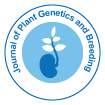Unravelling Plant Physiology and Proteomics: A Multi-Omics Approach to Crop Improvement
Received Date: Mar 01, 2025 / Published Date: Mar 27, 2025
Abstract
Plant physiology, the study of plant function and processes, has long been crucial for understanding how plants respond to their environment and how they maintain growth, development, and reproduction. Traditional approaches to improving crop yield and resilience have primarily focused on selection based on observable traits. However, as the global population continues to grow, the pressures on food production systems intensify, and the need for sustainable agriculture becomes more pressing. This has led to a shift toward more advanced methods for improving crops, particularly through molecular and multi-omics approaches. Among these, proteomics the study of the plant proteome (the complete set of proteins expressed by a plant at a given time) has emerged as an essential tool in understanding plant function at a deeper level. By integrating proteomics with other "omics" disciplines such as genomics, transcriptomics, and metabolomics, researchers can now study the complex interactions that govern plant physiology in a comprehensive manner. This multi-omics approach provides a more detailed understanding of how plants adapt to stresses, such as drought, heat, and disease, and how these adaptations can be harnessed for crop improvement. The combination of proteomics and plant physiology in crop improvement strategies offers unprecedented opportunities for developing crops that are more resilient, nutritious, and productive in the face of environmental challenges.
Citation: Prithviraj SK (2025) Unravelling Plant Physiology and Proteomics: AMulti-Omics Approach to Crop Improvement. J Plant Genet Breed 9: 265.
Copyright: © 2025 Prithviraj SK. This is an open-access article distributed underthe terms of the Creative Commons Attribution License, which permits unrestricteduse, distribution, and reproduction in any medium, provided the original author andsource are credited.
Select your language of interest to view the total content in your interested language
Share This Article
Open Access Journals
Article Usage
- Total views: 435
- [From(publication date): 0-0 - Dec 20, 2025]
- Breakdown by view type
- HTML page views: 352
- PDF downloads: 83
